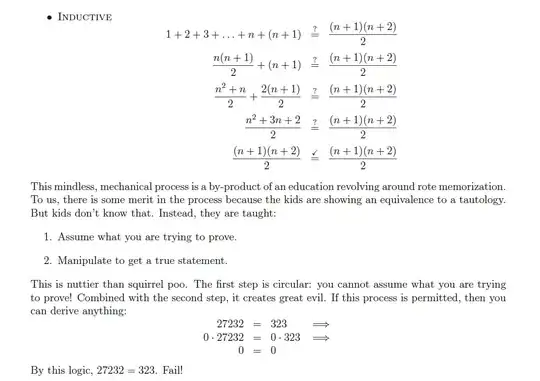I'm reading a Math lecture note on mathematical induction, and in it, the author condemns a way of concluding that $\ P(n) \implies P(n+1)\ $, which is done by assuming $\ P(n+1)$, making a few deductions, and arriving at a $ \mathtt{True}\ $ statement. I'll give a very elementary example of proving an identity involving the sum of natural numbers.
Proof [Good]: Clearly, $n = 1$ works. Suppose the identity holds for $n$. Then adding $n+1$ to both sides of the identity, we get $ 1+2+\ ... \ +n+(n+1) = \frac{n(n+1)}{2}+\frac{2(n+1)}{2} = \frac{(n+1)(n+2)}{2}$. Thus $P(n) \implies P(n+1)$, which closes the induction.
Proof [Bad?]: $n=1$ works. Suppose the identity holds for $n$. Then we want to prove that $1+2+\ ... \ +n+(n+1) = \frac{(n+1)(n+2)}{2}$. Note that by our induction hypothesis, the $\mathsf{LHS}$ can be re-written as $\frac{n(n+1)}{2}+(n+1) = \frac{(n+1)(n+2)}{2}$, which equals the $\mathsf{RHS}$, which means that $P(n) \implies P(n+1)$, and we're done.
The author of the lecture note objects to [Bad?] because we're assuming what we wanted to prove, which is circular. However, I've seen a lot of induction proofs which are in the form of [Bad?], even in famous Math books. One example is an induction argument used to prove a very elementary fact about natural numbers, which I'll paraphrase from Terry Tao's Analysis I book:
Theorem: For any natural number $n$, $n+0 = n$. Proof: Clearly $n = 0$ works. Assume that $n+0 = n$, for any natural $n$. We wish to show that $\ S(n)+0 = S(n)\ $ (here $\ S(n)$ denotes the successor of $n$). Note that $\ S(n)+0 = S(n+0) = S(n)$, which means that $S(n) = S(n)$, and we're done.
In fact, inductive proofs in the form above are used many times in Terry Tao's book. Is there anything wrong with such proofs?
Edit: In case I wasn't clear, here's a snippet of the lecture note.
